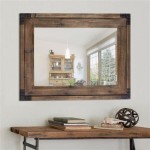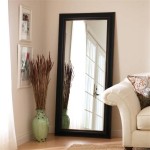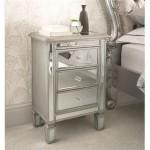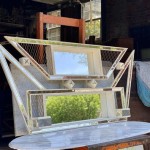How To Antique a Mirror
Antiquing a mirror involves creating the appearance of age and wear, adding a touch of vintage charm to any space. Several techniques can achieve this effect, each offering varying degrees of control and complexity.
Before beginning any antiquing process, the mirror must be thoroughly cleaned. Use a glass cleaner and a lint-free cloth to remove any dust, fingerprints, or residue. A clean surface is essential for proper adhesion of the antiquing mediums.
One of the most popular methods uses a specialized antiquing solution. These solutions are readily available at craft stores and come in a variety of shades, allowing for customization of the final look. Before applying the antiquing solution, protect the back of the mirror with painter's tape and newspaper or masking paper to prevent unwanted staining.
Applying the antiquing solution requires a specific technique. Some solutions are sprayed onto the mirror surface, while others are brushed on. Follow the manufacturer's instructions carefully for the best results. For a subtle, aged look, a thin, even coat is recommended. For a more dramatic effect, multiple layers can be applied, allowing each layer to dry thoroughly before applying the next.
Another technique involves using paint to achieve an antique effect. This method offers greater control over the color and texture of the final product. Acrylic paints are well-suited for this purpose due to their versatility and ease of use. Water-based paints offer easier cleanup and lower odor compared to oil-based alternatives.
When using paint, the desired effect dictates the application technique. A dry brush technique can create a textured, aged appearance. This involves dipping a stiff-bristled brush lightly in the paint, removing excess paint on a paper towel, and then lightly dragging the brush across the mirror's surface. This creates a streaked, uneven effect that mimics the wear and tear of time.
Alternatively, a layered approach with paint can create a more opaque antique finish. Thinned layers of paint, allowing each layer to dry before applying the next, allow for adjustments to the color intensity and build depth. This technique can also be used to create a gradient effect, with the color being more concentrated towards the edges of the mirror and fading towards the center.
A third method involves the use of a chemical etching cream. This technique, while more advanced, offers a permanently etched antique finish. Etching cream contains chemicals that react with the mirror's surface, creating a frosted or etched look. This method requires careful handling and adherence to safety precautions, including wearing gloves and eye protection. Follow the manufacturer’s instructions precisely for safe and effective application.
The application of etching cream typically involves masking off areas of the mirror that should remain untouched. This can be accomplished using stencils or painter's tape to create patterns or borders. The etching cream is then applied to the exposed areas and left for the duration specified by the manufacturer. After the designated time, the cream is rinsed off, revealing the etched design.
Black tea can also be used to create a subtle antique effect. Brew a strong solution of black tea and allow it to cool. Apply the tea to the mirror surface using a spray bottle or a soft cloth. The tannins in the tea will react with the mirror, creating a gentle discoloration that mimics age. This method is best suited for creating a lightly antiqued look.
Regardless of the chosen method, proper sealing is crucial for preserving the antiqued finish. Once the antiquing medium is completely dry, apply a sealant designed for glass surfaces. This will protect the finish from moisture, scratches, and other damage, ensuring the longevity of the antiqued effect.
Different sealants offer varying levels of protection and sheen. A matte sealant will preserve the aged appearance without adding any gloss. A gloss sealant, conversely, will add a layer of shine to the antiqued mirror. Select the sealant that best complements the desired aesthetic.
Experimentation with different techniques and mediums can yield unique and personalized results. Consider combining techniques, such as layering paint over an antiqued solution or using a dry brush technique with a tinted sealant, to achieve a truly custom antique finish. Careful preparation and attention to detail are crucial for achieving a professional-looking result.

How To Antique A Mirror Tutorial Jenna Sue Design

How To Antique A Mirror

How To Antique A Mirror Tutorial Jenna Sue Design

The Ultimate Guide On Diy Antique Mirrors So Much Better With Age

The Ultimate Guide On Diy Antique Mirrors So Much Better With Age

How To Antique A Mirror Easy Diy Tutorial

How To Antique A Mirror Tutorial Jenna Sue Design

Diy Antique Mirror Easy To Do And Looks Authentic My Creative Days

How To Antique Mirror Using Paint Stripper And Bleach Decor Adventures

How To Antique A Mirror Easy No Scratching The Navage Patch








